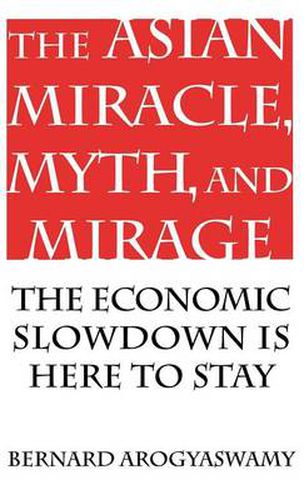Readings Newsletter
Become a Readings Member to make your shopping experience even easier.
Sign in or sign up for free!
You’re not far away from qualifying for FREE standard shipping within Australia
You’ve qualified for FREE standard shipping within Australia
The cart is loading…






Double-digit economic growth is not unusual among Asian countries and, in fact, has come to be expected of them. From western India to northeastern China, markets are booming and incredible numbers of foreign investors are entering the Asian markets. Scholars have written laudatory books and articles, politicians want to ensure that trade with Asian countries continues on a rising trajectory, and business leaders have become the new promoters of Asian prosperity. This book attempts to inject a note of caution and reality, while giving Asian countries well-deserved credit for improving their economic status. Technological, managerial and institutional deficiencies need to be addressed in Asian countries if the progress of the past two decades is to be maintained. Although Asian nations, particularly Japan, have invested heavily in R&D, their success mainly derives from process improvements and not from new product innovations. Technology and science are the foundations of modern economic civilization, and Asia falls behind Western countries in both areas. The centrality of family-based organizations in some Asian economies and the dependence on horizontal/vertical networks in others also limits the ability of Asian firms to become global operations. The lack of adequate institutions such as an independent judiciary and a responsive polity, and the absence of organizations to bridge the gap between familism and the government, results in an uncertain societal framework in much of Asia.
$9.00 standard shipping within Australia
FREE standard shipping within Australia for orders over $100.00
Express & International shipping calculated at checkout
Double-digit economic growth is not unusual among Asian countries and, in fact, has come to be expected of them. From western India to northeastern China, markets are booming and incredible numbers of foreign investors are entering the Asian markets. Scholars have written laudatory books and articles, politicians want to ensure that trade with Asian countries continues on a rising trajectory, and business leaders have become the new promoters of Asian prosperity. This book attempts to inject a note of caution and reality, while giving Asian countries well-deserved credit for improving their economic status. Technological, managerial and institutional deficiencies need to be addressed in Asian countries if the progress of the past two decades is to be maintained. Although Asian nations, particularly Japan, have invested heavily in R&D, their success mainly derives from process improvements and not from new product innovations. Technology and science are the foundations of modern economic civilization, and Asia falls behind Western countries in both areas. The centrality of family-based organizations in some Asian economies and the dependence on horizontal/vertical networks in others also limits the ability of Asian firms to become global operations. The lack of adequate institutions such as an independent judiciary and a responsive polity, and the absence of organizations to bridge the gap between familism and the government, results in an uncertain societal framework in much of Asia.